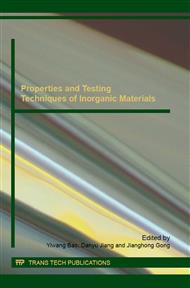[1]
S. Theil, M. Fleischhammer, P. Axmann, et al., Experimental investigations on the electrochemical and thermal behaviour of LiCoPO4-based cathode, J. Power Sources. 222 (2013) 72–78.
DOI: 10.1016/j.jpowsour.2012.08.069
Google Scholar
[2]
A. K. Rai, T. V. Thi, J. Gim, S. Kim, J. Kim, Li3V2(PO4)3/ graphene nanocomposite as a high performance cathode material for lithium ion battery, Ceram. Int. 41 (2015) 389–396.
DOI: 10.1016/j.ceramint.2014.08.082
Google Scholar
[3]
J. L. Li, J. H. Wu, Y. Wang, G. B. Liu, C. Chen, H. Liu, Synthesis of LiFePO4/C composite with high rate capability using spheniscidite as a facile precursor, Mater. Lett. 136 (2014) 282–285.
DOI: 10.1016/j.matlet.2014.08.099
Google Scholar
[4]
J. Yoon, S. Muhammad, D. Jang, et al. Study on structure and electrochemical properties of carbon-coated monoclinic Li3V2(PO4)3 using synchrotron based in situ X-ray diffraction and absorption, J. Alloys Compd. 569 (2013) 76–81.
DOI: 10.1016/j.jallcom.2013.03.188
Google Scholar
[5]
B. Pei, Z.Q. Jiang, W.X. Zhang, et al., Nanostructured Li3V2(PO4)3 cathode supported on reduced graphene oxide for lithium-ion batteries, J. Power Sources, 239 (2013) 475–482.
DOI: 10.1016/j.jpowsour.2013.03.171
Google Scholar
[6]
J.H. Yao, S.S. Wei, P.J. Zhang, et al., Synthesis and properties of Li3V2-xCex(PO4)3/C cathode materials for Li-ion batteries. J. Alloys Compd. 532 (2012) 49–54.
DOI: 10.1016/j.jallcom.2012.04.014
Google Scholar
[7]
S.X. Liu, H.B. Yin, H.B. Wang, et al., Synthesis, characterization and electrochemical performances of MoO2 and carbon co-coated LiFePO4 cathode materials, Ceram. Int. 40 (2014) 3325–3331.
DOI: 10.1016/j.ceramint.2013.09.102
Google Scholar
[8]
F.Q. Cheng, W. Wan, Z. Tan, et al., High power performance of nano-LiFePO4/C cathode material synthesized via lauric acid-assisted solid-state reaction, Electrochim. Acta. 56 (2011) 2999–3005.
DOI: 10.1016/j.electacta.2011.01.007
Google Scholar
[9]
Y.N. Ko, J.H. Kim, Y.J. Hong, Y.C. Kang, Electrochemical properties of nano-sized Li3V2(PO4)3/C composite powders prepared by spray pyrolysis from spray solution with chelating agent, Mater. Chem. Phys. 131 (2011) 292–296.
DOI: 10.1016/j.matchemphys.2011.09.044
Google Scholar
[10]
C. Gao, H. Liu, G. B. Liu, et al., High-rate performance of xLiFePO4·yLi3V2(PO4)3/C composite cathode materials obtained via polyol process, Mater. Sci. Eng., B. 178 (2013) 272–276.
DOI: 10.1016/j.mseb.2012.11.016
Google Scholar
[11]
J. Xiang, J. Tu, L. Zhang, et al., Improved electrochemical properties of 9LiFePO4·Li3V2(PO4)3/C composite prepared by a simple solid-state method, J. Power Sources. 195 (2010) 8331–8335.
DOI: 10.1016/j.jpowsour.2010.06.070
Google Scholar
[12]
L. Wang, Synthesis and Study on Electrochemical Properties of xLiFePO4×yLi3V2(PO4)3/C Cathode Materials, Hunan University China(Master degree), 2014, 05.
Google Scholar
[13]
P. Z. Gao, L. Wang, D.Y. Li, et al., Electrochemical performance of LiFePO4@C composites with biomorphic porous carbon loading and nano-core-shell Structure, Ceram. Int. 40 (2014) 13009–13017.
DOI: 10.1016/j.ceramint.2014.04.164
Google Scholar
[14]
S.K. Zhong, L. Wu, J. Q. Liu. Sol–gel synthesis and electrochemical properties of 9LiFePO4·Li3V2(PO4)3/C composite cathode material for lithium ion batteries, Electrochim. Acta. 74 (2012) 8– 15.
DOI: 10.1016/j.electacta.2012.03.181
Google Scholar
[15]
C. S. Dai, F. P. Wang, J. T. Liu, D. L Wang, X. G. Hu, Li3V2(PO4)3 of Synthesis by Sol-gel Method and Properties, Chinese. J. Inorg. Chem. 24(3)(2008)381-387.
Google Scholar
[16]
S. Y. Chung, J. T. Bloking, Y.M. Chiang, Electronically conductive phospho-olivines as lithium storage electrodes, Nat. Mater. 1(2)(2002)123–128.
DOI: 10.1038/nmat732
Google Scholar
[17]
P. Z. Gao, B. Yan, L. Wang, W. Liu, W. W. Gong, X. P. Liu, Influence of calcined temperatures on the microstructure and electrochemical properties of LiFePO4/C nano-particles with a core-shell structure and It's thermal stability study, J. Ceram Process. Res. 16 (1)(2015).
Google Scholar
[18]
J. F. Zhang, C. Shen, B. Zhang, et al., Synthesis and performances of 2LiFePO4·Li3V2(PO4)3/C cathode materials via spray drying method with double carbon sources, J. Power Sources. 267 (2014) 227–234.
DOI: 10.1016/j.jpowsour.2014.04.153
Google Scholar
[19]
F. Yu, S. H. Lim, Y. D. Zhen, Y. X. An, J. Y. Lin. Optimized electrochemical performance of three- dimensional porous LiFePO4/C microspheres via microwave irradiation assisted synthesis. J. Power Sources. 271 (2014) 223-230.
DOI: 10.1016/j.jpowsour.2014.08.009
Google Scholar
[20]
B. F. Wang, Y. L. Qiu, L. Yang. Structural and electrochemical characterization of LiFePO4 synthesized by an HEDP-based soft-chemistry route, Electrochem. Commun. 8 (2006) 1801–1805.
DOI: 10.1016/j.elecom.2006.07.034
Google Scholar
[21]
Y. M. Bai. Influence on the Performance of Lithium Iron Phosphate of Carbon Source and Metal Ions Doping. Hunan University China(Doctor degree), 2011, 05.
Google Scholar


